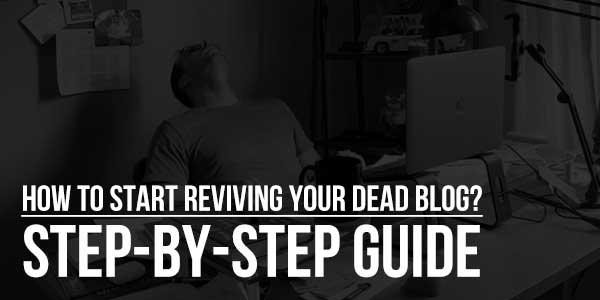
Have you noticed your once-thriving blog collecting digital dust? Don’t worry – blog resurrection is more common than you think. Whether you took an unplanned hiatus or simply lost momentum, this comprehensive guide will walk you through the exact steps to revive your dead blog and make it flourish again.
“A dormant blog isn’t dead – it’s just sleeping. With the right strategy, you can wake it up stronger than ever.” – Blogging Experts
Table of Contents
Why Most Blogs Die (And How To Avoid These Mistakes)
Before we dive into revival strategies, let’s understand why blogs typically fail:
- Inconsistent Publishing: Irregular content updates confuse both readers and search engines
- Lack Of Clear Focus: Trying to cover too many topics dilutes your authority
- Ignoring SEO Fundamentals: Without proper optimization, your content remains invisible
- Failure To Engage Audience: One-way communication leads to dwindling readership
- Burnout: Many bloggers quit when they don’t see immediate results
Step 1: Conduct A Comprehensive Blog Audit
Begin your revival journey by assessing your blog’s current state. This isn’t just about counting posts – it’s a deep diagnostic checkup.
Technical Health Check
Use tools like Google Search Console to identify:
- Broken links (404 errors)
- Indexing issues
- Mobile usability problems
- Page speed concerns
Content Performance Analysis
Review your analytics to determine:
- Top-performing posts (potential to expand)
- Underperforming content (needs updating or removal)
- Visitor behavior patterns (bounce rate, time on page)
Step 2: Refresh Your Best Performing Content
Your existing content is gold – especially pieces that already rank well or have attracted backlinks. Here’s how to maximize them:
Content Updates That Matter
For each high-potential post:
- Update statistics and outdated information
- Enhance with new examples or case studies
- Add multimedia (videos, infographics, podcasts)
- Improve formatting for better readability
SEO Optimization Refresh
Re-optimize your content with:
- Fresh keyword research
- Better meta descriptions
- Strategic internal linking (connect to newer posts)
- Schema markup where applicable
Step 3: Develop A Sustainable Content Strategy
Consistency beats intensity in blogging. Create a realistic publishing calendar you can maintain long-term.
Content Pillar Approach
Organize your topics into 3-5 main pillars with supporting subtopics. This creates a logical structure that both readers and search engines appreciate.
Mix Content Types
Variety keeps your blog fresh:
- How-to guides
- Listicles
- Case studies
- Interview posts
- Opinion pieces

Step 4: Re-Engage Your Dormant Audience
Your previous readers are your most valuable asset. Win them back with these tactics:
Email Reactivation Campaign
Craft a compelling email sequence that:
- Acknowledges your absence honestly
- Highlights what’s new/changed
- Offers exclusive value to returning readers
Social Media Revival
Leverage platforms where your audience hangs out:
- Share your best evergreen content with new insights
- Run polls or Q&A sessions to spark interaction
- Consider short-form video teasers of your content
Step 5: Implement Modern SEO Techniques
Search algorithms have evolved. Ensure your revived blog meets current standards.
Technical SEO Must-Dos
Prioritize these technical aspects:
- Mobile-first optimization
- Core Web Vitals improvements
- Structured data implementation
- XML sitemap updates
Content SEO Enhancements
Apply these content-level optimizations:
- Semantic keyword usage (natural language)
- Comprehensive content covering topics in-depth
- Authoritative outbound links to trusted sources
Step 6: Build A Community Around Your Revived Blog
Transform passive readers into active community members for sustainable growth.
Engagement-Boosting Tactics
Encourage interaction through:
- Thought-provoking questions at the end of posts
- Reader spotlight features
- Exclusive content for engaged community members
Collaboration Opportunities
Expand your reach by:
- Guest posting on relevant blogs
- Inviting industry experts for interviews
- Participating in podcast appearances
Step 7: Monetization Strategies For Your Revived Blog
A revived blog should eventually support itself. Consider these revenue streams:
Beginner-Friendly Options
Start with low-barrier methods:
- Affiliate marketing for products you genuinely recommend
- Sponsored content from aligned brands
- Digital products (checklists, templates, eBooks)
Advanced Monetization
As your audience grows, explore:
- Online courses or workshops
- Membership programs
- Coaching or consulting services
Frequently Asked Questions (FAQs)
How Long Does It Take To Revive A Dead Blog?
Typically 3-6 months of consistent effort, depending on your blog’s previous authority and current competition in your niche.
Should I Delete Old Posts When Reviving My Blog?
Only remove content that’s irrelevant or harmful to your brand. Instead of deleting, consider updating or consolidating old posts.
Is It Better To Start A New Blog Or Revive An Old One?
Reviving is usually better – you retain any existing domain authority, backlinks, and brand recognition.
How Often Should I Post When Reviving My Blog?
Start with a manageable frequency (1-2 quality posts weekly) rather than overwhelming yourself with daily posts you can’t sustain.
Can Changing My Blog’s Niche Help In Revival?
Only if your current niche is oversaturated or you’re genuinely passionate about the new direction. Pivoting requires careful planning.
What’s The First Sign That My Blog Revival Is Working?
Increased returning visitors and improved engagement metrics (comments, social shares, time on page) typically appear before significant traffic growth.
How Much Should I Invest In Reviving My Blog?
Focus first on sweat equity. Later, consider strategic investments like professional design updates or premium tools that save time.
Should I Change My Blog’s Design During Revival?
A refresh can help, but prioritize functionality over aesthetics. Ensure your design improves user experience and loading speed.
How Do I Stay Motivated During The Revival Process?
Set small, measurable goals and celebrate milestones. Connect with other bloggers for accountability and support.
When Should I Consider Professional Help For Blog Revival?
If you’re struggling with technical aspects (SEO, site speed) or need content strategy expertise, hiring help can accelerate your revival.
Final Thoughts: Your Blog’s Second Chance
Reviving a dead blog requires patience and persistence, but the rewards make it worthwhile. Remember that many successful bloggers have walked this path before you. By methodically implementing these steps – from technical audits to content refreshes and community rebuilding – you’re not just reviving your blog, you’re setting it up for greater success than before.
Ready to breathe new life into your digital presence? Start with one step today, and soon you’ll see your blog transform from dormant to dynamic. For more blogging insights, explore our comprehensive guide collection.














Be the first to write a comment.